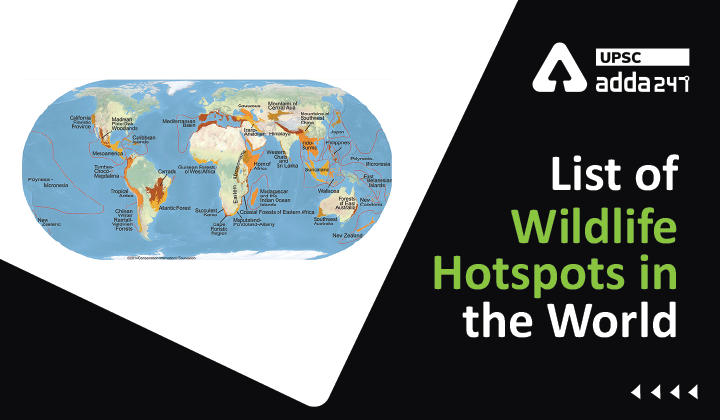Table of Contents
What are biodiversity hotspots?
- The term ‘biodiversity hotspot’ was first coined by Norman Myers (1988).
- He recognized 10 tropical forests as “hotspots” according to the level of plant endemism and high level of habitat loss. It, however, did not have any quantitative criteria for designating a region’s ecological hotspot.
- Two years later, he added eight more hotspots, which increased the number of hotspots in the world increased to 18.
- Conservation International (CI), subsequently, associated with Myers and made the first systematic update of the hotspots.
- CI then introduced the following two strict quantitative criteria, for a region to qualify as a hotspot:
- At least 1,500 species of vascular plants should be present (> 0.5% of the world’s total) as endemics;
- Should have lost ≥ 70% of its original native habitat.
Biodiversity hotspots in the world
- According to Conservation International, there are 36 biodiversity-rich areas in the world that have been qualified as hotspots.
- These regions represent just 2.5% of the earth’s land surface but support over 50% of the world’s endemic plant species.
- It includes nearly 43% of bird, mammal, reptile, and amphibian species as endemics.
List of biodiversity hotspots in the world
| Sl. No. | Name of the Hotspot | Location |
| 1. | Tropical Andes | South America |
| 2. | Tumbes-Choco-Magdalena | South America |
| 3. | Madrean Pine–Oak Woodlands | North and Central America |
| 4. | Cerrado | South America |
| 5. | Chilean Winter Rainfall and Valdivian Forests | South America |
| 6. | Atlantic Forest | South America |
| 7. | Mesoamerica | North and Central America |
| 8. | Caribbean Islands | North and Central America |
| 9. | California Floristic Province | North and Central America |
| 10. | Guinean Forests of West Africa | Africa |
| 11. | Cape Floristic Region | Africa |
| 12. | Succulent Karoo | Africa |
| 13. | Maputaland–Pondoland–Albany | Africa |
| 14. | Coastal Forests of Eastern Africa | Africa |
| 15. | Eastern Afromontane | Africa |
| 16. | Horn of Africa | Africa |
| 17. | Madagascar and the Indian Ocean Islands | Africa |
| 18 | Mediterranean Basin | Europe and Central Asia |
| 19. | Caucasus | Europe and Central Asia |
| 20. | Irano-Anatolian | Europe and Central Asia |
| 21. | Mountains of Central Asia | Europe and Central Asia |
| 22. | Western Ghats and Sri Lanka | South Asia |
| 23. | Himalaya | South Asia |
| 24. | Mountains of Southwest China | East Asia |
| 25. | Indo-Burma | South Asia |
| 26. | Sundaland | Southeast Asia and Asia-Pacific |
| 27. | Wallacea | Southeast Asia and Asia-Pacific |
| 28. | Philippines | Southeast Asia and Asia-Pacific |
| 29. | Japan | East Asia |
| 30. | Southwest Australia | Southeast Asia and Asia-Pacific |
| 31. | East Melanesian Islands | Southeast Asia and Asia-Pacific |
| 32. | New Zealand | Southeast Asia and Asia-Pacific |
| 33. | New Caledonia | Southeast Asia and Asia-Pacific |
| 34. | Polynesia–Micronesia | Southeast Asia and Asia-Pacific |
| 35. | Forests of East Australia | Southeast Asia and Asia-Pacific |
| 36. | North American Coastal Plain | North and Central America |
Read UPSC favorite topics
| Follow US | |
| UPSC Govt. Jobs UPSC Current Affairs UPSC Judiciary PCS Download Adda 247 App here to get the latest updates |





 TSPSC Group 1 Question Paper 2024, Downl...
TSPSC Group 1 Question Paper 2024, Downl...
 TSPSC Group 1 Answer key 2024 Out, Downl...
TSPSC Group 1 Answer key 2024 Out, Downl...
 Cabinet Ministers of India 2024, New Cab...
Cabinet Ministers of India 2024, New Cab...







